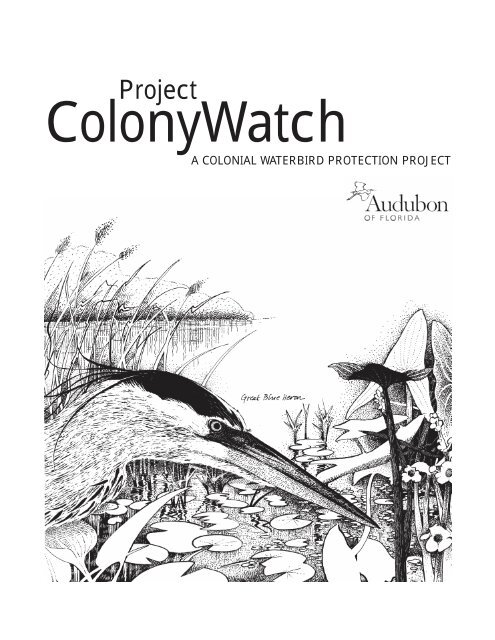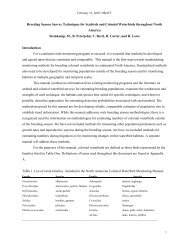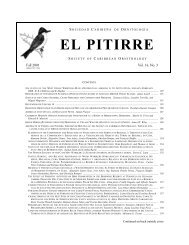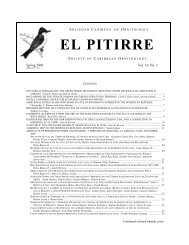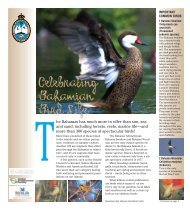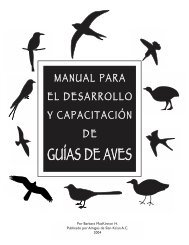Colony Watch Handbook - National Audubon Society
Colony Watch Handbook - National Audubon Society
Colony Watch Handbook - National Audubon Society
You also want an ePaper? Increase the reach of your titles
YUMPU automatically turns print PDFs into web optimized ePapers that Google loves.
<strong>Colony</strong><strong>Watch</strong>ProjectA COLONIAL WATERBIRD PROTECTION PROJECT
Project <strong>Colony</strong><strong>Watch</strong> <strong>Handbook</strong>Written by Richard T. Paul and Ann F. PaulFor technical assistance, contact Florida Coastal Islands Sanctuaries.Tel. 813 623-6826, Fax 813 623-4086Line drawings are the copyright property of Mary Beath, and have been used with permission of the artist.This handbook may be copied without further permission to facilitate Project <strong>Colony</strong><strong>Watch</strong> activities andfor educational purposes.Published 2004 by <strong>Audubon</strong> of Florida. 444 Brickell Ave, Suite 850. Miami, FL 33131<strong>Audubon</strong> of Florida is a strategic alliance of the <strong>National</strong> <strong>Audubon</strong> <strong>Society</strong> and the Florida <strong>Audubon</strong><strong>Society</strong>. Its mission is “To conserve, protect, and restore Florida's natural resources and to create a cultureof conservation among all Floridians.”AcknowledgmentsThis publication was produced by <strong>Audubon</strong> of Florida with significant funding from the Ocean Fund of RoyalCaribbean Cruises. Additional production funding from the Sarasota Bay <strong>National</strong> Estuary Program and theTampa Bay Estuary Program is much appreciated. Thanks to Susan Cumins and Sally Treat for their editorialassistance, and Nancy Douglass, Bill Pranty, Dr. Paul Gray, Dr. Jerry Lorenz, Dr. Mark Kraus, Rick Sawicki,Gar Urette, Tammy Lyons, Joyce King, Sandra Bogan, Irela Bagué, and Diane Murray for their review.i
Table of ContentsCredits and Acknowledgements ______________ iTable of Contents __________________________ iiBackground & Goal ________________________ 1<strong>Colony</strong> Facts ______________________________ 2Steps for a Great <strong>Colony</strong><strong>Watch</strong> Project ________ 3Key Questions ____________________________ 4A Few Definitions __________________________ 5Tips for Ground-Nesting Bird Surveys__________ 6<strong>Colony</strong> Census Techniques __________________ 6Direct Counts ____________________________ 6The Flight-Line Estimation Technique ______ 7A Word about Disturbance __________________ 9Using Your Information ____________________ 10Tips for Dealing with the Media ______________ 11Data Sheets ______________________________ 12<strong>Colony</strong> Flight-Line Survey Form __________ 13<strong>Colony</strong> Census Form __________________ 14<strong>Audubon</strong> and Agency Resources ____________ 15ii
BackgroundAlong the Florida Gulf coast, more than 25 species of birds gather to nest in “colonies,” or groups, thatmay total a few dozen to many thousand breeding pairs. Colonies are typically located on islands or inmarshes and swamps over water, to provide isolation from terrestrial predators and other disturbance.Habitat losses associated with a variety of human activities, and a rapidly growing human population inFlorida, have resulted in the destruction of some colony sites and the disturbance of many more. In manycases, even unintended disturbance may cause the mortality of hundreds of eggs or young. Coastal coloniesare especially vulnerable to disturbance because of their accessibility to beach-goers and recreational boaters.Colonies are sensitive to disturbance because many birds gather to literally "lay their eggs in the samebasket." This feature, however, enables fairly effective protective measures to be designed and carried out.Hundreds, or even thousands, of nests can be protected at once. Further, the eye-catching spectacle of somany birds all nesting together offers an excellent opportunity to educate the public about wildlife, and theneed to preserve and manage wildlife habitat, both at the nesting site itself and at nearby wetland foraging areas.GoalThe goal of Project <strong>Colony</strong><strong>Watch</strong> is to protect the important breeding colonies of Florida’s coasts throughthe assistance and involvement of <strong>Audubon</strong> chapters and other volunteers. <strong>Colony</strong><strong>Watch</strong> volunteers will usethe colonies and the birds themselves as powerful educational devices to build the constituency for wildlifein their local communities.Remember, people love wildlife — especially birds — because they are colorful, active, and familiar. Theproject will attract attention, and the birds themselves will be their own best ambassadors. Project <strong>Colony</strong><strong>Watch</strong>is a way for knowledgeable, involved individuals to ensure a future for wildlife in Florida. By protecting thesecolonial nesting sites, we can keep common birds common and increase populations of birds which havebeen declining recently. Interested?Call <strong>Audubon</strong>’s Project <strong>Colony</strong><strong>Watch</strong> staff at 813 623-6826.1
<strong>Colony</strong> FactsMany of Florida’s most spectacularwaterbirds nest in groups calledcolonies. Pelicans, cormorants,anhingas, herons, egrets, ibises,spoonbills, storks, gulls, terns,skimmers — in fact, at least 25species in the state — can becalled “colonial.” A colony mayinclude just a few nests, or thousands,and may occur on an island or ina marsh or swamp, usually overstanding water. Regardless of thelocation, a key feature of the colonysite is that it is free of terrestrialpredators like raccoons — or it islocated where access by terrestrialpredators is very difficult. Often,freshwater colony sites are protectedfrom raccoons by patrolling alligators.For over 70 years some of themost important colonies in Floridahave been protected as <strong>Audubon</strong>Sanctuaries. Others lie within <strong>National</strong>Wildlife Refuges or <strong>National</strong> Parkboundaries. But most colonies—some numbering in the thousandsof breeding pairs—lack formalprotected status.How can we help to protectthem? The steps are easy andanyone can participate. The onlyrequirement is a willingness toget started.2
A Few Definitions1. A breeding colony is an area where birds of one or more species gather in numbers to nest. Where mostof the nesting birds are herons, it is appropriate to use the synonym heronry. Another synonym is rookery,although some limit this term to colonies of rooks, a colonial corvid of Europe. Penguins and northernseabirds like murres, auks, etc. are commonly said to nest in rookeries. A colony can be as small as twonests, or as large as 5,000 or more.2. A roost is where non-nesting birds aggregate to spend the night or part of the day.3. The incubation period is the time when adult birds are incubating the eggs, ranging from 20–22 days forthe smaller herons to about 32 days for brown pelicans.4. Brood stage or guard stage is the period when young birds in the nest are continuously attended by aparent. This is a period when the young nestlings are small enough to be easily taken by a predatorsuch as a fish crow or night-heron. For small herons, the brood stage lasts about 12–14 days, while forlarger herons it lasts three weeks or more. In pelicans the brood stage lasts about four weeks.5. Fledging generally refers to the time or age at which a nestling is first capable of flight. Small heronsfledge at the age of four to five weeks. Brown pelicans fledge at 11 weeks. For some time after fledging(two weeks for small herons, up to four weeks for great blue herons, etc.), the parent birds continue tofeed their young at or near the colony.6. A breeding pair is confirmed by noting one or more of the following criteria:• two adults standing together in the nest or at a nest site (usually represents a pair early in the nestingcycle; they may not have eggs yet);• an adult in the nest, standing or crouched in incubating or brooding position;• a nest containing eggs or young (usually with an adult in attendance);• a brood of one or more large young, standing in or near a nest (if several young are in the area, theobserver must make a decision about how many broods are represented).5
<strong>Colony</strong> Census TechniquesNo single census technique is best for all situations. Selection ofthe best method always represents a compromise between the needfor accuracy and the need to avoid disturbance at a colony.Remember, the key questions are 1) what kinds of birds and 2) howmany breeding pairs of birds nest at your Project <strong>Colony</strong><strong>Watch</strong> site.1. Direct CountsThe most accurate census technique is a direct count of nestsor nesting pairs. A direct count is appropriate where the colony siteis small and/or easily accessible, and the nests or nesting birds canbe seen easily. Large birds, species with conspicuous coloration, andthose that nest in sparse vegetation or on top of the tree/shrubcanopy, lend themselves to direct counts. In Florida, the larger birdsthat nest in the tree tops are typically brown pelicans, double-crestedcormorants, anhingas, great blue herons, and wood storks. Directcounts can also be used effectively for ground-nesting birds such asgulls, terns, and skimmers, although laughing gulls nesting in tallgrass can be hard to see.To carry out a direct count, observers may walk carefully aroundthe perimeter of the colony, identifying and counting nests. <strong>Colony</strong> entrywill cause disturbance, and should be avoided (See A Word aboutDisturbance, page 10). Fish crows and other birds will use the disturbanceas an opportunity to steal eggs and even small young. Colonies oncoastal islands can be circled at a distance repeatedly by boat untilcounts are complete. (Hint: do not use canoes for coastal colonycounts, since visibility is poor from the low position, and wave actioncan interfere with the ability to make a reasonable count. However,canoes may be useful in the still waters of freshwater swamps.)Tips for Ground-NestingBird SurveysIt is very important toconsider the well-being of birdsaffected by the count. Earlymorning is a good time to conductcounts of ground-nesting birds,because the temperature is coolerthen, reducing stress on theadults, eggs, or young. It isimportant to finish the count bymid-morning, before the mid-daytemperature rises. It goes withoutsaying that ground-nesting birdsuse camouflage to protect theireggs and young from predation,so census-takers must watchtheir footing carefully to avoidstepping on eggs or chicks.DO NOT ENTER THE COLONY ITSELF.Very large colonies can be difficult to survey by direct count.Sometimes it is useful to make a careful count of a smaller area, andthen extrapolate to estimate nesting in areas of similar habitat structureand nesting densities. Often, a good solution is to ask multiple observersto compare counts, and use cooperation to arrive at reasonable estimates.6
<strong>Colony</strong> Census Techniques (continued)2. The Flight-line TechniqueHerons, egrets, ibises, and spoonbills often nest out ofsight, below the canopy, so that direct counts are not possible.Another sampling technique is necessary. Some techniquesrequire extensive colony entry and may cause significantmortality due to disturbance (see A Word about Disturbance,page 10). A flight-line estimation technique is generallypreferred because reasonable nesting population estimatescan be obtained from a distance, without impacting nesting.This method is based on the knowledge that nestingwading birds take turns at the nest, each parent incubatingthe eggs or brooding the young while the mate forages forfood. Usually the male leaves the colony at sunrise andforages for two to four hours. Upon his return to the nest,the female flies off, returning in the afternoon. The greaterregularity of the morning foraging flight allows moreaccurate estimates than afternoon counts. (Night-heronscannot be censused successfully with this techniquebecause they forage primarily at night.)Flight-line 1MarkerlFlight-line 2MarkerlcolonylMarkercolonyll• Observer /BoatPosition• Observer /BoatPositionIt is possible to estimate the number of pairs in acolony by measuring the flight rate of adults leaving andreturning to the colony along a flight-line. However, themethod is valid only if flight counts are made under thefollowing conditions:• Good weather! Avoid wind speeds exceeding 15mph, since they will affect the flight-line and yourboating safety.• When most or all of the breeding pairs are in theincubation or guard stage of nesting.• In the morning, between about 8 A.M. and 12 noon.Or start counts between one and two hours after sunrise.• Observers should be positioned 100 yards or morefrom the colony, where they can see flight-lines wellwithout disturbing nesting birds at all. Use binoculars!Flight-line 3Observer /BoatPosition• llMarkercolonylMarkerlMarker7
<strong>Colony</strong> Census Techniques (continued)The idea is to count all inbound and outbound adult herons, ibis, or spoonbills in standard counts ofeach flight-line. Normally two or more count periods are necessary at each colony, since the “traffic” maycome from any direction and observers must sample all possible flight-lines. One-hour counts are best,although future research may confirm that half-hour counts are sufficient at large colonies. All counts areadded together, to give a total number of birds in and out per hour from all sides of the colony. That’s theflight rate. The flight rate is multiplied by 1.5 to give an estimate of the number of breeding pairs.Here's an example, based on one-hour counts. For simplicity, we’ll assume there is only one species present:Flight-Line # 1 2 3 Total# of birds inbound 10 24 6 40# of birds outbound 12 19 8 39Total/hour = flight rate (FR) 22 43 14 79# of pairs = (FR) X 1.5 118The flight-line technique should be tried out a couple of times, just to get comfortable with it and to discussquestions that arise. Try it with a team of two people, with one acting as the observer and the other as recorder.To repeat, this method works best if all pairs in the colony are incubating or in the guard stage. But inFlorida, with our long nesting season, colonies are rarely so synchronized. If your colony has some birdsincubating, some with small young and some with large young, <strong>Audubon</strong> staff can help you apply a correctionfactor to the estimate, based on the proportion of nests with large young. Accuracy gradually declines asthe nesting season progresses, and by late in the nesting season flight-line estimates may not be reliable.In mid-nesting season, however, this technique is a simple and appropriate way to census a colony withoutcausing any disturbance at all.Note: Although this technique shows considerable promise, it is still experimental. <strong>Audubon</strong> staff andother biologists are continuing to test and fine-tune the technique.8
A Word about DisturbanceThe whole idea of Project <strong>Colony</strong><strong>Watch</strong> is to improve the protection of a colony. Therefore it is essentialthat <strong>Colony</strong><strong>Watch</strong> volunteers make every effort to avoid flushing adults from their nests or otherwise disruptingtheir activities. Besides, it’s illegal to disturb nesting birds, no matter how good your intentions are! Of course,you must always obtain the permission of the landowner to be on the site – otherwise, you are trespassing.The key problem with disturbance is forcing the adult bird to leave the nest, where it is protecting itseggs or young chicks. Once the adults have flown, predators like fish crows, gulls, or black-crownednight-herons can raid the nests, taking the vulnerable eggs or young. If people walk too close to nests withyoung chicks in them, the young may leave their nests in a desperate effort to get away from the perceived"predator." In many cases, nestlings may not be able to return to their own nests. Since the adultsfeed their young in or near their nests but not elsewhere, young birds on the colony floor will be left tostarve. Black vultures are often seen in bird colonies, waiting for young to fall out of nests. Alligators, whichprovide a benefit by keeping raccoons and other tree-climbing predators out of bird colonies in freshwaterswamps, are quick to take advantage of fallen nestlings.Heat stress is another significant factor when adults are flushed from their nests, especially for groundnestingbirds like gulls, terns, and skimmers. The summer sun’s heat can literally cook the eggs or youngin a matter of minutes, if the parents are not there to shade them. A 20-minute visit to a bird colony by acareless human or a pet dog can destroy an entire colony’s reproductive effort for the whole year.If you think you may need to enter a colony, please consult <strong>Colony</strong><strong>Watch</strong> staff, or state or federal wildlifeagency biologists in advance.9
Using Your InformationIt is very important to use your information strategically. After all, the colony can't protect itself! Start bypreparing a brief report soon after the nesting season ends, summarizing the results of your colony surveysin a table. Include survey dates, the species seen, the numbers of breeding pairs, and any other informationyou think important. Do note any apparent threats to the stability of the nesting site or the safety of the birds,like erosion, disturbance, presence of predators, etc. And be sure to list the names of your <strong>Colony</strong><strong>Watch</strong>team! You can use the Data Sheets provided in this <strong>Handbook</strong> to help organize your report. This should besimple, not difficult, so if you bog down, call us for assistance.Once your report is complete, decide who should see it. Here's where you get strategic. Certainly,<strong>Audubon</strong> <strong>Colony</strong><strong>Watch</strong> staff will want to see it. So will the local biologists of the Florida Fish and WildlifeConservation Commission. Some other suggestions: your county or city environmental and planning agencies,U. S. Fish and Wildlife Service Office of Ecological Services, the local Water Management District, and soon (see Agency Resources, page 16). Local planning and development review processes and wildlifeagencies cannot protect bird colonies if they don’t know that the colonies are there.Others who may be interested in your colony information include members of the press, your local<strong>Audubon</strong> chapter members and leaders (be sure to write an article for your chapter newsletter about yourfindings and experiences), and school groups, etc. In fact, elementary school classes or high school ecologyclubs may be able to design and implement a colony census project as part of their curriculum! Forinstance, Sarasota High School has had such a project since 1998. You can also put your information onthe chapter’s website.Newspaper articles and TV coverage are a great way to tell the world about your chapter's activitiesand about the nesting birds. By telling your community, you build awareness and support for the birds,and for colony protection.All bird colonies are not secure. If they were, we wouldn’t need <strong>Colony</strong><strong>Watch</strong>. A <strong>Colony</strong><strong>Watch</strong> projectis a way of learning about a bird colony and monitoring nesting numbers in order to prevent impacts. Butsometimes problems arise. When that happens, <strong>Colony</strong><strong>Watch</strong> volunteers already have the information thatlets them assess the damage (potential or actual), already know what agencies to contact, and havedeveloped community awareness about the site. If you've already developed a relationship with agency staff,it's easy to call when you really need to.You don’t have to be an “expert,” either. All you have to do is have your <strong>Colony</strong><strong>Watch</strong> information at hand,present your concern, and ask good questions. Some problems, like oil or chemical spills, require promptattention. Others, like island erosion, may take years to solve. Progress may be slow, but stay the course.Be concerned and persistent but polite. Find partners to support your position, too.10
Using Your Information (continued)Actually, you ARE the expert. Often, a site under developmentconsideration will be visited by a consultant biologist for a couple ofhours to determine if there are any sensitive wildlife species present.If the visit is outside the nesting period, the consultant (or agencystaffer who's reviewing the project) may never recognize the site’svalue to wildlife. Your census information, collected at the right timeof year, is the best possible proof of the importance of the site, andoffers the best opportunity to predict potential impacts of the proposedproject. In addition, the census data may be useful if the colony isdisturbed by an accident (such as an oil spill) or intentionally, whenit comes time to assess damages or impose fines.We’re here to help you help birds!Remember: <strong>Audubon</strong>’s Project <strong>Colony</strong><strong>Watch</strong> staff are alwaysavailable to answer questions. Call us! 813 623-6826THANK YOU VERY MUCH for your help in making Project<strong>Colony</strong><strong>Watch</strong> a success! And thank you for working to protect thenesting colonial waterbirds of Florida.Tips for dealing withthe media:• Be clear, concise, andfactual. Do not exaggerate. If youdon’t know the answer to a question,say so. You can also say that youdon’t know but will look into it andget back with them. And sometimesvery interesting discussionsresult from reviewing issues fromseveral sides, without reaching thedefinitive “answer.”• Provide an organizedsummary table of bird numbersat the colony. Use the <strong>Colony</strong>Census Form provided as a guide,if you wish.• Make ecosystemconnections: note that wadingbirds must have productive wetlandforaging habitats if they are tonest successfully, that birds inan estuary need fisheries to beproductive, that fishing line entanglementcan be a problem, etc.For assistance with contactingyour local media and approachesto sharing information about thecolony with the press, contactyour Project <strong>Colony</strong><strong>Watch</strong> staff.11
Data SheetsFollowing are two data sheets to help you in your field work. Make as many photocopies of these sheetsas you need.The first data sheet is the <strong>Colony</strong> Flight-Line Survey Form. Use one sheet per flight-line, and anotherto summarize your data. For each species, indicate whether most pairs are incubating, or have smallyoung or large young.The second data sheet is the <strong>Colony</strong> Census Form. On this form, please provide your best count orestimate of nesting pairs and indicate the census technique used. For some species, it may be possible tocount the number of young in broods. This is especially valuable in evaluating nesting success (i.e., youngper nest). Brood counts are easiest with large birds or treetop nesters like brown pelican, double-crestedcormorant, anhinga, great blue heron, great egret, or wood stork. Count broods if you can, but don’t worryif it isn’t possible.A few noncolonial species are included on the <strong>Colony</strong> Census Form. Snowy plovers, Wilson’s plovers,American oystercatchers, and willets often nest in or near coastal colonies. Information on their presenceis of special interest because of their rarity, and the restricted nature of their habitats.12
<strong>Colony</strong> Flight-Line Survey<strong>Colony</strong> Name ________________________Time ______________________to __________________________Date ________________________________Wind ____________________Clouds ______________________Observer(s) __________________________Tide __________________________________________________(On reverse: draw a map of the colony indicating the observer’s position.)SPECIESSTAGE OFNUMBER INBOUND NUMBER OUTBOUNDBREEDINGAnhingaGreat Blue HeronGreat EgretSnowy EgretLittle Blue HeronTricolored HeronReddish EgretCattle EgretBlack-crownedNight-HeronYellow-crownedNight-HeronWhite IbisGlossy IbisRoseate SpoonbillWood StorkStage of breeding:I = Incubation, S = Small young, L = Large youngNote: You will need to perform the <strong>Colony</strong> Flight-Line summary computations on another worksheet.13
<strong>Colony</strong> Census FormDate ________________________<strong>Colony</strong> Name __________________Time ________________________County________________________Observer(s) ____________________FFWCC # ____________________Species Nesting Census Method and Comments Broods with: FFWCCpairs1 young 2 young 3 young Listing*Brown PelicanSSCDouble-crested CormorantAnhingaLeast BitternGreat Blue HeronGreat EgretSnowy EgretSSCLittle Blue HeronSSCTricolored HeronSSCReddish EgretSSCCattle EgretGreen HeronBlack-crowned Night-HeronYellow-crowned Night-HeronWhite IbisSSCGlossy IbisRoseate SpoonbillSSCWood StorkESnowy PloverTWilson’s PloverAmerican OystercatcherSSCWilletLaughing GullGull-billed TernCaspian TernRoyal TernSandwich TernLeast TernTBlack SkimmerSSCTotal pairs in colonyIf this survey was based on a flight-line estimate, please attach <strong>Colony</strong> Flight-Line data sheets.Make notes of other pertinent colony information on back of sheet or on attached pages.*Florida Fish & Wildlife Conservation Commission listings:E = Endangered, T = Threatened, SSC = Species of Special ConcernMany wading bird colonies have been assigned an official "colony number" by the Florida Fish & WildlifeConservation Commission during periodic aerial surveys. Ask your Project <strong>Colony</strong><strong>Watch</strong> staff if your colonyhas a FFWCC number.
<strong>Audubon</strong> and Agency Resources<strong>Audubon</strong> of Floridawww.audubonofflorida.org<strong>Audubon</strong> of Florida, Main Office and EvergladesConservation Office444 Brickell Avenue, Suite 850Miami, FL 33131305/371-6399fax 305/371-6398<strong>Audubon</strong> Resource Management Offices<strong>Colony</strong><strong>Watch</strong>, Important Bird Areas, andFlorida Coastal Islands Sanctuaries410 Ware Boulevard, Suite 702Tampa, FL 33619813/623-6826fax 813/623-6826Corkscrew Swamp Sanctuary375 Sanctuary Road WestNaples, FL 33964239/348-9151fax 239/348-9145Tavernier Science Center115 Indian Mound TrailTavernier, FL 33070305/852-5092fax 305/852-8012Lake Okeechobee Sanctuary100 Riverwoods CircleLorida, FL 33857863/467-8497fax 863/467-8460Center for Birds of Prey1101 <strong>Audubon</strong> WayMaitland, FL 32751407/644-0190fax 407/644-8940Florida Fish & Wildlife Conservation Commissionwww.fwc.state.fl.usWildlife Alert Hotline (toll-free)Report wildlife violations, poaching, etc.1-888/404-3922FFWCC Main Office620 South Meridian StreetTallahassee, FL 32399-1600850/488-1960FFWCC Office of Informational Services850/488-4676FFWCC Division of Law Enforcement850/488-6251FFWCC Division of Wildlife850/488-3831FFWCC Great Florida Birding Trail850/922-0664FFWCC Bureau of Protected Species Management850/922-4330FFWCC Wildlife and Environmental Services Office29200 Tuckers GradePunta Gorda, FL 33955941/575-5765FFWCC Environmental Services Office255 154th AvenueVero Beach, FL 32968-9041561/778-509415
<strong>Audubon</strong> and Agency Resources (continued)FFWCC Law Enforcement OfficesPensacola 850/595-8978Carrabelle 850/697-3741Panama City 850/233-5150Tallahassee 850/488-6251Crystal River 352/447-1633Lakeland 863/648-3200Lake City 904/758-0529Fort Myers 941/332-6911Tampa 813/272-2516Jupiter 561/624-6935Miami 305/956-2300Everglades/West Palm Beach 561/625-5128Marathon 305/289-2320FFWCC Regional Bureau of Wildlife DiversityConservation OfficesAsk for your Regional BiologistFFWCC Southwest Regional Office3900 Drane Field RoadLakeland, FL 33811863/648-3203FFWCC Northwest Regional Office3911 Highway 2321Panama City, FL 32409-1658850/265-3676FFWCC South Regional Office8535 Northlake BoulevardWest Palm Beach, FL 33412561/625-5122FFWCC North Central Regional OfficeRoute 7, Box 440Lake City, FL 32055386/758-0525Water Management District Officeswww.watermatters.orgSouthwest Florida Water Management District2379 Broad StreetBrooksville, FL 34609-6899352/796-7211St. Johns River Water Management DistrictP.O. Box 1429Palatka, FL 32178904/329-4500Northwest Florida Water Management District81 Water Management DriveHavana, FL 32333850/539-5999South Florida Water Management DistrictP.O. Box 24680West Palm Beach, FL 33416561/686-8800Suwannee River Water Management District9225 County Road 49Live Oak, FL 32060904/362-1001FFWCC Northeast Regional Office1239 Southwest 10th StreetOcala, FL 34474-2797352/732-122816
<strong>Audubon</strong> and Agency Resources (continued)<strong>National</strong> Estuary Programs in FloridaSarasota Bay <strong>National</strong> Estuary Program111 South Orange Avenue, Suite 200WSarasota, FL 34236941/951-3650fax 941/951-3659www.sarasotabay.orgTampa Bay Estuary Program100 Eighth Avenue SEMail Station I-1/NEPSt. Petersburg, FL 33701727/893-2765fax 727/893-2767www.tbep.orgIndian River Lagoon ProgramPalm Bay Service Center525 Community College Parkway S.E.Palm Bay, FL 32909321/984-4950 or 800/226-3747fax 321/984-4937www.sjrwmd.comCharlotte Harbor <strong>National</strong> Estuary ProgramSouthwest Florida Regional Planning Council4980 Bayline Drive, 4th floorP.O. Box 3455North Fort Myers, FL 33917239/995-1777fax 239/656-7724www.charlotteharbornep.orgU.S. Fish and Wildlife ServiceEcological Services OfficesUSFWS Panama City Field Office1601 Balboa AvenuePanama City, FL 34205-3721850/769-0552fax 850/763-2177www.panamacity.fws.govUSFWS Tampa Bay Field Office9549 Koger Boulevard, Suite 111St. Petersburg, FL 33702727/570-5398fax 727/570-5549www.tampa.fws.govUSFWS Jacksonville Field Office6620 Southpoint Drive, #310Jacksonville, FL 32216-0912904/232-2580fax 904/232-2404www.northflorida.fws.govUSFWS South Florida Field Office1339 20th StreetVero Beach, FL 32960772/562-3909fax 772/562-4288verobeach.fws.gov17
<strong>Audubon</strong> and Agency Resources (continued)Florida Department of Environmental Protectionwww.dep.state.fl.usFDEP - Main Office3900 Commonwealth BoulevardTallahassee, FL 32399850/245-2307FDEP Southwest District Office3804 Coconut Palm DriveTampa, FL 33619813/744-6100, fax 813/744-6084FDEP Northwest District Office160 Governmental CenterPensacola, FL 32502850/595-8300, fax 850/595-8414FDEP South District Office2295 Victoria Avenue, #364Fort Myers, FL 32902239/332-6975, fax 239/332-6969FDEP Northeast District Office7825 Baymeadows Way, #B200Jacksonville, FL 32256-7590904/807-3300, fax 904/448-4319FDEP Central District Office3319 Maguire Boulevard, #232Orlando, FL 32803407/897-7555, fax 407/897-2966FDEP Southeast District Office400 North Congress Avenue, Suite 200West Palm Beach, FL 33401561/681-6600, fax 561/681-6755Department of Environmental Protection's AquaticPreserves and State Buffer Areas ProgramMain Office3900 Commonwealth Blvd., Mail Station 235Tallahassee, FL 32399-3000850/245-2094Aquatic Preserve and State Buffer Areas Field OfficesApalachicola <strong>National</strong> Estuarine Research Reserve350 Carroll Street, Eastpoint, FL 32328850/670-4783Biscayne Bay Aquatic PreserveBiscayne Bay Environmental Center1275 NE 79th Street CSWYMiami, FL 33138-4206305/795-3485Charlotte Harbor State Buffer Preserve12301 Burnt Store RoadPunta Gorda, FL 33955941/575-5861Crystal River State Buffer Preserve3266 North Sailboat AvenueCrystal River, FL 34428352/563-1136Estero Bay State Buffer Preserve700-1 Fishermans WharfFt. Myers Beach, FL 33931941/463-3240Florida Keys <strong>National</strong> Marine Sanctuary216 Ann Street, Key West, FL 33040305/92-031118
<strong>Audubon</strong> and Agency Resources (continued)Guana Tolomato Matanzas <strong>National</strong> EstuarineResearch Reserve9741 Ocean Shore Blvd.St. Augustine, FL 32080904/461-4054North Fork, St. Lucie River State Buffer Preserve9737 Gumbo Limbo TrailJensen Beach, FL 34957-2214561/873-6590Pumpkin Hill Creek State Buffer Preserve13802 Pumpkin Hill RoadJacksonville, FL 32226904/696-5944Terra Ceia State Buffer Preserve130 Terra Ceia RoadTerra Ceia, FL 34250941/721-2068Wekiva River Aquatic Preserve8300 West State RoadSanford, FL 32771407/330-6727Yellow River Marsh Aquatic Preserve7255 Highway 90 EastMilton, FL 32583850/983-5359Rainbow Springs Aquatic Preserve19152 SW 81 Place RoadDunnellon, FL 34432352/489-7516Rookery Bay <strong>National</strong> Estuarine Research Reserve300 Tower RoadNaples, FL 34113941/417-6310St. Joseph Bay State Buffer Preserve3915 Highway 30-CPort St. Joe, FL 32456850/229-1787St. Sebastian River State Buffer Preserve1000 Buffer Preserve DriveFellsmere, FL 32948407/953-500419


